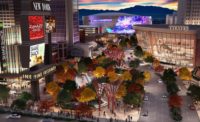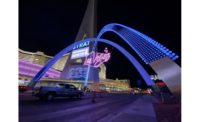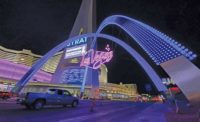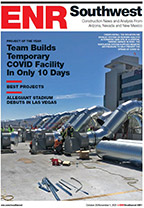MGM Resorts International garners ENR Southwest’s Owner of the Year title primarily due to the scope, influence and performance of the projects the company develops.
Article Index:
“They are truly a world-class owner, and we are proud to work for them,” says Richard Copeland, chairman of Thor Construction. “They are a tough owner to work for, but that just makes us a better contractor.”
Thor has worked on a multitude of projects with MGM over approximately two decades.
Copeland says the on-time, on-budget approach of MGM inspired his firm to think of a construction schedule not just in terms of months and days but in hours and minutes. Consequently, the strategy has increased Thor’s efficiency.
Bill Ham, president of facility operations for MGM Resorts, says MGM’s process and attention to detail is a result of decades of project development.
“A project is identified, and the business foundation is set regarding level of investment and program. It is turned over to the design and construction teams. The project is developed to a concept-design state and is shared with senior management,” Ham says. “Once approved by senior management, it is then further developed through design development. During the entire process, the budget and schedule is being developed.”
The higher profile the project, the more senior management becomes involved on budget and schedule, which inevitably engages more oversight, Ham observes.
MGM Resorts operates 13 resorts and casinos in Las Vegas and owns and operates several other properties. Over the past decade, some of the company’s most notable projects have included the MGM Festival Grounds and the $9-billion CityCenter complex, which includes Aria Resort and Casino and the Vdara Hotel.
Building Las Vegas
Currently, MGM Resorts is nearing completion on a $375-million arena with its partner, AEG (see story, p. SW32). The privately funded site will host its first event in April.
Further, adjacent to the new arena, crews are constructing The Park, a $100-million immersive outdoor destination that spans more than eight acres and includes an open-air entertainment promenade linking the New York-New York and the Monte Carlo. The two hotels’ park-facing facades will be transformed with a series of indoor-outdoor dining and entertainment venues.
Also under construction on the same block is the Entertainment Theater at Monte Carlo, a 5,000-seat, $100-million project featuring a lower-section seating bowl that can be pushed back for smaller shows. The designer, Montreal-based Sceno Plus, is developing similar theaters at MGM Resorts’ two under-construction megaprojects in Maryland and Macau. MGM Resorts is directly assuming the general contractor role on the Entertainment Theater at Monte Carlo.
Crews have reached substantial completion on MGM’s Mandalay Bay Convention Center renovation, although minor details are still in process, according to Copeland, whose firm served as contractor. The Mandalay Bay center now boasts more than 2 million total sq ft and more than 900,000 sq ft of contiguous exhibit space. The $66-million project also includes the construction of more than 350,000 sq ft of exhibit space as well as underground parking. Further, the convention-center project includes one of the largest rooftop solar photovoltaic arrays in the world: The company’s first commercial solar project in the U.S., the 6.4-MW installation generates enough electricity to power 1,000 homes.
“In a number of respects, MGM is one of the leading owners out there,” says Neil Opfer, associate professor at University of Nevada, Las Vegas’ department of civil and environmental engineering and construction.
However, Opfer says the controversy surrounding the 6.7-million-sq-ft CityCenter, which included the Harmon Hotel, was one instance where the company struggled. In 2008, during construction of the 400-room, 49-story Harmon tower, defects were uncovered in the structural steel. By December 2014, Harmon was being dismantled, and a settlement between contractor Tutor-Perini and some subcontractors avoided what was expected to be a year-long civil case. MGM Resorts International declined to comment on the case.
During construction of CityCenter—at the time, the largest privately financed development in the U.S.—costs skyrocketed due to cost increases that were tied to an employee walkout in 2008 and the collapsing economy. In the end, the project cost rose to $9 billion from the originally estimated $4 billion, Opfer says.
Despite the Harmon setback, Opfer says MGM continues to remain active within the community, even allowing, for example, student tours when many other owners no longer do.
Diversity Counts
Since 1999, MGM Resorts has taken a proactive approach to extending construction work to minority and disadvantaged construction firms. The company uses partnerships, mentorships and job segmentation within the program, which offers work in new development and construction as well as maintenance and renovation of existing facilities.
“They’ve been really good with minority hiring practices,” Opfer says.
According to Copeland, Thor Construction was involved in the program from the start and that MGM’s efforts have set a bar that has yet to be matched by any other owner in the country.
“When [former CEO] Terry Lanni announced that program, he said it would be a world-class program and that MGM would be a leader in diversity. They have achieved it,” Copeland says.
Although it took a year or so for the diversity program to result in an awarded contract, Copeland says his firm and others have benefitted for more than a decade. In addition to serving as the general contractor on the Mandalay Bay Convention Center, Thor performed concrete work on the MGM/AEG arena. Further, he says confidential future work is also in the early stages.
“It’s the continuation of a relationship we are proud to call the best relationship we have with any owner,” Copeland says.








Post a comment to this article
Report Abusive Comment